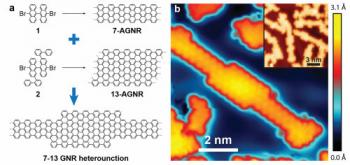Researchers at the US Department of Energy's (DOE) Lawrence Berkeley National Laboratory (Berkeley Lab) and the University of California, Berkeley, have developed a new approach for synthesizing graphene nanoribbons from pre-designed molecular building blocks. Using this process the researchers built nanoribbons that have enhanced properties (tunable bandgaps, for example) that can be potentially useful for advanced electronics.

Conservative nanoribbon synthesis methods commonly involve etching ribbons out of larger 2D sheets of graphene or unzipping nanotubes. These methods, however, sometimes lack precision and do not grant enough control over the resulting material. In this study, the researchers managed to create atomically-precise nanoribbons with non-uniform shape (instead of the traditional constant width ribbons) by manipulating the shapes of the molecular building blocks. The scientists claim they are able to achieve great precision, and modulate nanoribbon width from 0.7 nm to 1.4nm, creating junctions where narrow nanoribbons fuse into wider ones.
This capability is groundbreaking, and can grant scientists the freedom to manipulate properties like bandgap and various quantum mechanical properties to assemble unique structures for myriad new functional devices. This new capability will, of course, need to be implemented to make electronic circuits and the researchers hope that it will eventually create new device elements, like diodes, transistors, and more - that are smaller and more powerful than those in current use. In the long run, they hope to incorporate nanoribbons into complex circuits to receive better performance than today's traditional computer chips.
In December 2014, Berkeley Lab reported electric field switching of ferromagnetism at room temperature.
Source: Phys.org